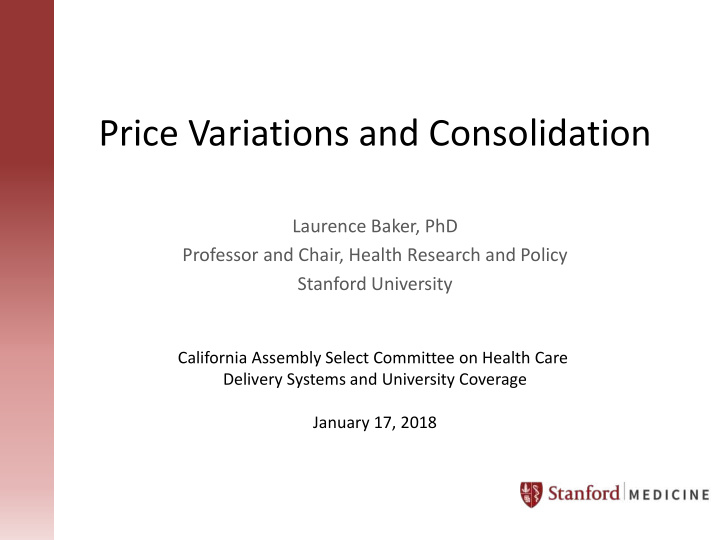



Price Variations and Consolidation Laurence Baker, PhD Professor and Chair, Health Research and Policy Stanford University California Assembly Select Committee on Health Care Delivery Systems and University Coverage January 17, 2018
Context • Current health care spending levels and trends raise the potential for serious strain, even harm • Prices are an important component of health care spending increases • We use market mechanisms to determine much of our health care spending – Markets can fail – Consolidation can be a particularly challenging issue
Source: http://www.healthcostinstitute.org/report/2015-health-care-cost-utilization-report /
Variation in Hospital Prices by HRR, 2008-2011 (adjusted for wages and patient risk) Source: http://www.healthcarepricingproject.org
Public and Private Payer Price Setting Commercial payers: prices negotiated between insurers and • providers – Often with few constraints – Bargaining ability a key factor, affected by consolidation, must-have status and other issues – Difficulty sustaining strong insurer bargaining when there is insufficient attention to price tradeoffs by the population – Challenges managing the use and price of new and costly innovations Traditional Medicare uses administratively set prices • Medicare Advantage plans negotiate prices with providers • – But with the constraint that providers have to accept Medicare rates if patients go to out-of-network providers Medi-Cal negotiates fee-for-service prices with hospitals and set • prices administratively for physicians; Medi-Cal managed care plans negotiate prices within the constraints established by FFS
Relative prices for hospital services paid by Medicare Advantage, fee-for-service Medicare, and commercial insurance plans, 2009 and 2012. (FFS Medicare set at 100 in each year) 180 165.2 160 146.3 140 120 100 100 92.6 100 91.5 80 60 40 20 0 2009 2012 Medicare Advantage FFS Medicare Commercial Data from Baker, Bundorf, Devlin, and Kessler, “Medicare Advantage Plans Pay Hospitals Less than Traditional Medicare Pays,” Health Affairs 35:8 (August 2016); Exhibit 2. Relative prices are based on average prices from 66 CBSAs with data from each payer type for each of the 25 most common DRGs in 2009, and 125 CBSAs with data from each payer type for each of the 25 most common DRGs in 2012.
Source: Selden, Karaca, Keenan, White, Kronick, “The Growing Difference Between Public and Private Payment Rates for Inpatient Hospital Care” Health Affairs, 34:12 (December 2015). Derived from MEPS data on average payment rates for nonmaternity stays, adjusted for inflation and patient age, sex, race/ethnicity, geography, household income, conditions, charges, LOS, and presence of surgical procedure. See additional notes in Exhibit 1 in supplementary slides.
Hospital Consolidation 561 hospital mergers since 2010 • Only 35% of hospitals independent (not in a system) in 2014 • About ½ of hospital markets are ”highly concentrated” • Most urban areas now dominated by 1-3 large systems • Statistics from M. Gaynor presentation “Consolidation and Competition in U.S. health care” Catalyst for Health Reform Summit, 2017 Figure from http://www.aha.org/research/reports/tw/chartbook/ch2.shtml
Other Consolidation Physician practices • – Share of physicians in practices with <10 physicians declines from about 48% to about 41% between 2009 and 2011 alone.* – Share of physicians in practices of 100+ more than doubles in the 2000s; now about 1/3 of all physicians Hospital-physician • – Reported significant increases in hospital-employed or affiliated physicians Insurers • – Median 2-firm concentration ratio in MSAs in 2014 = 0.7** Other: Insurer-provider, ACO, etc • *Source: Welch, Cuellar, Stearns, Bindman, Health Affairs 2013; also AMA data – 80% in <10 practices in 1983, down to 61% in 2014; **Source: 2014 AMA Competition in health insurance report, from Gaynor Catalyst presentation, 2017
Why Consolidation Response to consolidation by others • – And a desire not to be the last one left out Reactions to policy • – e.g. the ACA, payment reforms, meaningful use, etc Attempt to improve market position, enhance referrals, gain • pricing advantage Part of a trend toward consolidation even outside of health care • – Driven by IT, communications, management changes
Effects of Consolidation Considerable evidence suggests higher commercial prices • associated with physician, hospital, and physician-hospital consolidation Some evidence suggest lower prices associated with insurer • consolidation Quality evidence is underdeveloped, but shows mixed results • • Some large integrated delivery systems do seem to perform well • Many increases in consolidation have brought higher utilization, and not improved quality
Drivers of High Commercial Prices Consolidation • Other sources of market power • – e.g. “must-have” status of some providers Evolved high cost structures of providers • – Already completed construction, hiring – “medical arms races” Arrival of new and costly treatments • Lack of sufficient pressure from consumers • – Lack of knowledge – Distance from the negotiation setting
Policy Considerations Managing consolidation is important • – Pay attention to markets dominated by a small number of systems – It may be possible to monitor measures such as the “Hirschman- Herfindahl Index” (HHI) or the Concentration Ratio for areas – State efforts to review and influence consolidation may be needed Improving context for insurer bargaining • – Encouraging appropriate network design – Narrow networks can be a useful tool (regulatory restrictions on networks trade off bargaining power) – Limitations on out-of-network prices can have important effects (e.g. the Medicare Advantage evidence) Encouraging individual purchase of insurance, e.g. through • Covered California, can provide support for insurer bargaining
Policy Considerations Encouraging price transparency could be valuable • – Though not necessarily enough by itself Price regulation? • – In cases where markets are already highly consolidated, it may be difficult to reverse the trend – In some cases, high prices may be seen even without consolidation – Efficient price regulation may be difficult to do, but in a difficult situation may have a place at the table – Maryland All-Payer rate setting could be a model Unique issues for rural areas • Links between prices and overall system performance • – Better price control could help efforts to expand coverage, manage public expenditures
Recommend
More recommend